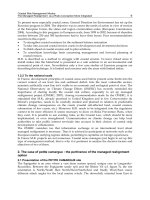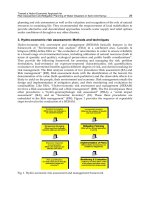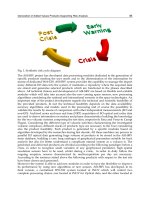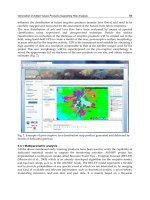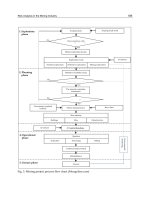LV Thạc sỹ_Account receivable management in Viglacera packings and brake JSC
Bạn đang xem bản rút gọn của tài liệu. Xem và tải ngay bản đầy đủ của tài liệu tại đây (472.97 KB, 66 trang )
NATIONAL ECONOMICS UNIVERSITY
ADVANCED EDUCATIONAL PROGRAM
*****************************
BACHELOR’S THESIS IN FINANCE
Account Receivable Management
in Viglacera Packings and Brake
Linings Joint Stock Company
ACKNOWLEDGEMENT
My thesis is completed with support of Dr…., Mr…, all employees in Viglacera
P&B Co, my friends in Advanced Finance Intake 50 and my family.
First of all, I would like to give special thanks and deepest gratitude to my
supervisor, Dr. …, for her advices and instructions. They are very helpful for me in
building the frame of my report. And her comments help me completed this report in
the best way.
I also want to thank Mr. … – chief accountant in the company I internshiped.
He is very enthusiasm for providing me all data and information I needed. His guides
about professional knowledge are really supportive for me.
My gratitude is also sent to all officers in Finance-Accounting Department for
their guides. Thanks to them, I get lots of useful working experiences through this
internship period. And it is my honor to work with them.
I highly appreciate all opportunities that I have been provide to practice and
learn about real business operations, as well as apply what I got from university to
solve real problems.
I want to thank all my classmates in Advanced Finance Intake 50 for their great
advices and creative ideas.
Finally, I offer my regards to my family for the support and encouragements.
TABLE OF CONTENTS
ACKNOWLEDGEMENT..............................................................................................i
TABLE OF CONTENTS...............................................................................................ii
ABSTRACT................................................................................................................... v
ABBREVIATION.........................................................................................................vi
LIST OF TABLES.......................................................................................................vii
LIST OF FIGURES....................................................................................................viii
INTRODUCTION..........................................................................................................1
CHAPTER 1. THEORETICAL FRAMEWORK OF ACCOUNT RECEIVABLE
MANAGEMENT...........................................................................................................5
1.1. Account receivable:..............................................................................................5
1.1.1. Definition:............................................................................................................. 5
1.1.2. Content of account receivables:............................................................................6
1.1.3. Roles of account receivables for an enterprise:.....................................................7
1.2. Account receivables management:......................................................................10
1.2.1. Definition:........................................................................................................... 10
1.2.2. Roles of account receivables management:.........................................................11
1.2.3. Account receivables management processing:....................................................11
1.2.3.1. Trade credit policy:..........................................................................................12
1.2.3.2. Analysis of customers’ prestige (6 C’s of credit):............................................16
1.2.3.3. Analysis of the proposed credit amount:..........................................................19
1.2.3.4. Monitoring account receivable:.......................................................................19
1.2.3.4.1. Days sales outstanding (DSO):.....................................................................20
1.2.3.4.2. Aging schedules:...........................................................................................21
1.2.3.4.3. Credit ratings:...............................................................................................22
CHAPTER 2. THE CURRENT SIATUATION OF ACCOUNT RECEIVABLE
MANAGEMENT IN VIGLACERA P&B CO.............................................................24
2.1. Overview of Viglacera Packings and Brake Lining Joint Stock Company:........24
2.1.1. The process of establishment and development of Viglacera P&B Co:..............24
2.1.1.1. General information:.......................................................................................24
2.1.1.2. The history of establishment and development:...............................................24
2.1.2. Major business activities:....................................................................................26
2.1.3. Organizational structure:.....................................................................................29
2.1.4. The market situation and competitors:................................................................30
2.1.5. Business results in three recent years:.................................................................31
2.2. The current situation of account receivable management in Viglacera P&B Co:
34
2.2.1. Account receivables in Viglacera P&B Co:........................................................34
2.2.2. Account receivable management in Viglacera P&B Co:.....................................37
2.2.2.1. The current trade credit policy of Viglacera P&B Co:.....................................37
2.2.2.2. Monitoring account receivables:......................................................................39
2.2.2.2.1. Days sales outstanding:................................................................................39
2.2.2.2.2. Aging schedule:............................................................................................40
2.3. Achievements and shortcomings of account receivable management in Viglacera
P&B Co:....................................................................................................................... 41
2.3.1. Achievements:....................................................................................................41
2.3.2. Shortcomings:.....................................................................................................42
2.3.3. Reasons for shortcomings in Viglacera P&B Co’s account receivable management:.43
2.3.3.1. Subjective reasons:..........................................................................................43
2.3.3.1.1. The company’s selling policy:......................................................................43
2.3.3.1.2. Human resource:...........................................................................................44
2.3.3.1.3. Technology:..................................................................................................44
2.3.3.1.4. Credit policy:................................................................................................44
2.3.3.1.4.5. Monitoring account receivable:.................................................................49
2.3.3.2. Objective reasons:...........................................................................................45
2.3.3.2.1. Business environment:..................................................................................45
2.3.3.2.2. Dishonesty of customers:..............................................................................46
CHAPTER 3. SOLUTION TO IMPROVE ACCOUNT RECEIVABLES
MANAGEMENT IN VIGLACER P&B CO................................................................47
3.1. Development orientation of Viglacera P&B Co in following years:...................47
3.1.1. Development orientation:....................................................................................47
3.1.2. Financial objectives:...........................................................................................47
3.1.3. Account receivable management objectives:......................................................47
3.2. Solutions to improve account receivable management in Viglacera P&B Co :...47
3.2.1. Human resources:...............................................................................................47
3.2.2. Technology:........................................................................................................48
3.2.3. Credit policy:......................................................................................................49
3.2.4. Monitoring account receivable:..........................................................................56
3.2.4. Other solutions:...................................................................................................51
CONCLUSION............................................................................................................52
REFERENCES
APPENDIX A. Income Statement
APPENDIX B. Balance Sheet
INTERNSHIP REPORT ASSESSMENT
ABSTRACT
As a student of National Economics University and especially as a finalyear student, I want to practice all my knowledge about economy, market, finance,
etc. that I learned from my lecturer and by myself. And in the internship period, I
have opportunity to practice in Viglacera Packings and Brake Linings Joint Stock
Company (Viglacera P&B Co) – a small and medium company to carry out my
knowledge to reality.
In a more and more complicated business environment as nowadays, a good
management will help the company be more successful than its competitors. After
researching Viglacera P&B Co’s business performance in recent years and receiving
consultants from many people, I decide to choose the topic about account receivable
management. Through my thesis, we will know achievements and shortcomings in
Viglacera P&B Co’s account receivable management. And in conclusion, I give my
own solutions and recommendation to help Viglacera P&B Co solve its problem in
account receivable management.
This thesis might get into inevitable issues and lead to further questions due to
limited knowledge, therefore I would be grateful to receive any constructive comments
to help my thesis better and have more practical value.
ABBREVIATION
CFO: Chief Financial Officer
DSO: days sales outstanding
ACP: average collection period
ADS: average daily sales
LIST OF TABLES
Table 1: Example of aging schedule.............................................................................21
Table 2: Viglacera P&B Co’s quantity and price of goods sold from 2009-2011.........32
Table 3: Key financial indicators of Viglacera P&B Co...............................................33
Table 4: Structure of account receivables in Viglacera P&B Co...................................35
Table 5: Structure of account receivables from customers...........................................36
Table 6: Viglacera P&B Co’s days sales outstanding...................................................39
Table 7: Viglacera P&B Co’s aging schedule...............................................................40
LIST OF FIGURES
Figure 1: Principle of account receivable management processing..............................11
Figure 2: The process of analyzing the customers’ prestige.........................................16
Figure 3: Organizational and managerial structure.......................................................29
Figure 4: Sales and profit growth.................................................................................31
Figure 5: Value of account receivables compared to total assets..................................34
1
INTRODUCTION
1.
Rationale:
Vietnam is integrating more and more deeply into world economy. This is
expressed through the active participation of Vietnam in economic forums in the
world. Vietnam has commercial relations with more than 165 nations and diplomatic
relations with over 171 countries in all continents. It is also the place where have
hosted many conferences of organizations like ASEAN, APEC, ASEM, etc. And
becoming the 150th member of WTO in 2007 is a major turning-point for Vietnam.
This opened many development opportunities for home enterprises such as expanding
the market, accessing to modern technology and investment capital sources from
foreign countries. However, it also brings difficulties like increasing competition
pressure for Vietnamese enterprises because of entering of many foreign brand names;
increasing risk of bankruptcy for weak companies, etc. In general, as integrating,
Vietnamese economy will be more influenced by fluctuations of the world economy.
In the last months of 2008, we witnessed what is being called the worst
financial crisis since the Great Depression of 1929-30. In 2009 and 2010, the world
economy still suffered repercussions of that crisis; just some economies had sign of
recovery. And in 2011, again, the world experienced another economic crisis. We can
see its influences clearly on Vietnamese enterprises though media channels and
newspapers. There are so many enterprises having difficulties, stopping production or
even going bankrupt. Hard economic conditions like high interest rate, inflation,
increases in the price of raw materials, petrol, gas, etc. make business environment
more arduous. As one of results, debts between enterprises and banks or between
enterprises are growing. Sometimes customers – are individuals or most are other
enterprises - buy products on credit. Especially with the current situation, because of
lacking capital, customers mainly buy on credit. Then, this transaction creates debts
among enterprises and those debts are recorded as account receivable in asset side of
balance sheet of the enterprise that is seller. Managing debts means managing account
receivables. With huge amount, account receivables have large effect on business
2
results. In many cases, damages due to increasing arrears by customers can lead to
bankruptcy. However, if managing well, account receivables can become competitive
advantages for enterprise to attract customers. So, account receivable management is
really important for an enterprise.
Through the internship period in Viglacera Packings and Brake Linings Joint
Stocks Company, I realized some problems in account receivable management. With
the practical significance is finding solutions to improve account receivable
management, I decide to choose the topic: “Account receivable management in
Viglacera Packings and Brake Linings Joint Stock Company” for my thesis.
2.
Research objectives:
2.1.
Systematize the basic theories of receivable management:
Based on knowledge I learned in university about receivable management, official
textbooks published by NEU and other reliable information from different sources, I will
clarify some basic theoretical issues of receivable management in enterprises in general.
Every theory has accurate basis and is associated with my research.
2.2.
Analyze the current situation of receivable management in Viglacera
P&B Company:
Based on information collected, I have overview of receivable management in
Viglacera P&B Co. Then I analyze and evaluate to find out strengthens, weaknesses,
successes or limitations on receivable management of company.
2.3.
Propose recommendations to enhance efficiency of receivable
management in Viglacera P&B Co:
Based on reasons for inefficiency of receivable management that I summarized,
also based on current business situation as well as the changes in the future, I forecast
fluctuations can happen to receivable management of company and give solutions and
recommendations to improve efficiency of this mission.
3
3.
Research questions:
To fit with my research objectives, through my paper, we will find the answers
for the following questions:
1. What is the theoretical framework of receivable management in an enterprise?
2. What is the current situation of receivable management in Viglacera P&B Co?
3. How to improve efficiency of receivable management in Viglacera P&B Co?
4.
Research scope:
4.1.
Time of data:
Data and information are collected in three recent years from 2009 to 2011. It
can reflect not exactly the real situation of company but in part it can show the results
in the most recent time and the efficiency of account receivable management of
Viglacera P&B Co at the time of study.
4.2.
Research subject:
Viglacera is a big corporation operating in many fields. However, I focus my
analysis on one of its subsidiaries – Viglacera Packings and Brake Linings Joint Stock
Company. This company operates in raw material processing industry. It has head
office in Tu Liem, Ha Noi. And major content of my report is its receivable
management
5.
Research methodology:
5.1.
Method of collecting data:
5.1.1. Primary data:
Working experience: through practicing in Accounting - Finance department of
Viglacera P&B Co, I’ve got experience and knowledge about finance in general
and receivable management in particular. I can know what the reality and the
problem in receivable management mission that the company is dealing with
are.
Face-to-face interviews: I’ve had opportunities to interview Director – Kieu
Bach, Accounting – Finance manager – Truong Do Tan, as well as other
4
employees in Accounting - Finance department and Sales department. Through
this kind of collecting data, I clarify my doubts and understand more about the
reality and problem in receivable management of company.
5.1.2. Secondary data:
Annual reports from 2009 to 2011: All data or financial figures in this paper are
taken from Viglacera P&B Co’s audited annual reports. And then they are used
to calculate ratios and indicators that are served to analyze the efficiency of
receivable management.
Internet: with an open source like Internet, I can easy to collect data and
knowledge related to my thesis. I use Google - a search tool and other websites
specializing in economics and finances that will be listed in ‘References’.
5.2.
Method of analyzing data:
5.2.1. Quantitative analysis:
For numerical data, I use them to calculate ratios and indicators. Then, in order
to assess more accurate and to see the trend or fluctuations, I show these data under
table or graph. Average industrial and economic levels are also applied to compare
with the current situation of the company.
5.2.2. Qualitative analysis:
Data related to management, marketing or product’s quality, etc. cannot be
assessed quantitatively, therefore they are analyzed qualitatively.
6.
Structure:
My thesis includes three main chapters, as follows:
Chapter 1:
Chapter 2:
Theoretical framework of account receivable management
The current situation of account receivable management in
Chapter 3:
Viglacera P&B Co
Solutions to improve
efficiency
management in Viglacera P&B Co
of
account
receivable
5
CHAPTER 1. THEORETICAL FRAMEWORK OF
ACCOUNT RECEIVABLE MANAGEMENT
1.1.
Account receivable:
When evaluating the financial situation of an enterprise, investors, bankers, or
business partners look at not only business results but also its debts. It must emphasize
that any enterprise or any economic organization always have amounts of money need
to be collected from debtors, or in accounting term, those amounts are called account
receivables. Account receivables never separate from business and production process
of an enterprises; it reflects the enterprise’s financial situation. And in the following
sections, we will study the concept and roles of account receivables for an enterprise.
1.1.1. Definition:
Account receivable is defined as an asset of the enterprise. It is calculated based
on all debts that the enterprise can’t collect whether it matures or not, and based on
unpaid transactions or any monetary obligation that other firms or individuals haven’t
pay for the enterprise yet.
Account receivables are recorded in asset side of balance sheet by accountants
because they reflect the sum will be paid in the future. The long-term receivables that
mature only after a relatively long period of time are long-term assets. And other shortterm receivables are treated as part of the current assets of the company. In accounting,
if the debts are paid within a period of less than one year (or in a business cycle), they
will be classified as current assets, but if more than one year or over a business cycle,
they are considered as long-term assets.
In reality, receivables is divided more detail in balance sheet into trade and nontrade receivables. Trade receivables arise from providing goods or services for
customers in the normal business cycle. Trade receivables may be account receivables
(short-term) or notes receivables (long-term). Non-trade receivables arise from other
transactions rather than providing goods or services and from promissory notes of
6
buyers. For example, advance amounts for employees, refunding amounts like tax
rebate, insurance indemnity, deposits and financial receivables like interest, dividends,
etc. However, in this paper, for simplicity, we use only “account receivable” term.
Account receivables often include the following items:
Receivables from customers
Advanced payments to suppliers
Intercompany receivables
Advances to employees
Mortgages, collateral, and deposits
Other receivables
1.1.2. Content of account receivables:
1.1.2.1. Receivables from customers:
Receivables from customers (also known as trade-account receivables) are the
debts owed to the enterprise by customers during the sales of goods and services in the
normal course of business. When a firm makes an ordinary sale of goods or services
and does not receive payment, the firm grants trade credits and creates accounts
receivable which could be collected in future. And in this case, we say the firm sells on
credit to customers. Customers can rely on funding through the form of deferredpayment sales of enterprises to have goods, raw materials for production. This form of
deferred-payment sales is an important short-term funding for almost all enterprises,
especially for commercial companies.
In developing economy, buyers often purchase goods or services that they can
pay immediately for cash or defer payments for a specific period of time with seller’s
permission. And seller of goods or services can collect cash immediately or must wait
a while. Sellers often extend credit than financial institutions - that is a form of credit
to customers. An account receivable is created when the enterprise grant credits to its
customers.
In condition of market economy, appropriating each other’s capital in business
and production activities of enterprises is a commercial feature. Even it is considered
as an effective business ‘tactic’ of enterprises operating in the market but not having
7
enough capital. Thus, account receivables management become particularly important
for enterprises that are appropriated capital at a high rate compared to venture capital.
1.1.2.2. Advanced payments to suppliers:
Advanced payments to suppliers are the amounts that enterprise must collect
from sellers, suppliers because enterprise paid in advance for sellers to purchase raw
materials, finished goods or services but haven’t received yet.
1.1.2.3. Intercompany receivables:
Intercompany receivables arise between companies with independent
accounting system and its subsidiary companies with separate accounting system or
between subsidiary companies.
1.1.2.4. Advances to employees:
Advances to employees are amounts of money or materials delivered to
officials or employees by company in order to perform the assigned tasks or to do
some jobs such as buying goods, paying costs, etc.
1.1.2.5. Mortgages, collateral, and deposits:
Mortgages often occur in relation to loans. With a mortgage loan, the borrower
must deliver his asset to lender in lending period.
Collateral is the amount of money that enterprise pays for owner when it rent
machines, equipments in order to bind and increase responsibility of renter in using
and returning leased property in time. Collateral amount is stipulated by owner and
may be higher than the value of leased asset.
Deposit is the amount of money or property paid in advance as security in
relations to trade, become sales agency, etc.
1.1.3. Roles of account receivables for an enterprise:
The more economy develops, the more diversified and complicate credit
relations are. We can say debt is unavoidable factor in business. Most enterprises when
conducting business activities have account receivables. They necessarily exist in an
8
enterprise. However, each enterprise has different value of receivables, from negligible
to uncontrollable level.
Account receivables can come from customers. It represents the amount that
customers owed enterprise in the process of selling goods or services under form of
presold-postpaid. This amount is essentially the capital appropriated by customers of
enterprise. In other cases, as purchasing materials, the enterprise must prepay to
suppliers and receive materials later. This transaction creates advances that are also
recorded as account receivables from suppliers. Besides, there are advances to
employees and other account receivables. In short, when an account receivable arises,
the enterprise paid cash for what will be received in the future. If this situation happens
in long-time, with large amount and high risk of un-recovery, it may be bad for
enterprise. And in this case, the enterprise will want to limit the size of receivables.
However, existence of account receivables also brings many benefits.
Especially in strict condition of trading in the market as nowadays, lending customers
and creating trade credit are good methods to broaden markets, increase competition
ability with rivals, and seek for new potential customers.
In the following parts, we will discuss in details the roles of account receivables
for the enterprise that is seller in a sales transaction.
1.1.3.1. The benefits of increasing account receivables:
To be able to stand firm and be competitive in the market, all enterprises must
take full advantages of their capabilities, resources as well as tools they are having. In
those things, credit policy is a ‘sharp weapon’ to help enterprise achieve sales goals.
Because when company loosens its credit conditions, it will have more customers,
more goods or services were sold. Trade credit can make company more prestigious,
create reputation in the market and make customers purchase the company’s products
more frequently. On the other hand, when loosening credit policy, the company can
clear away inventories, and costs related to inventory. Basically, trade credit is trust
between the party granting credits and the party receiving credits. Customers can
obtain a credit amount with more simple procedures. Because these are procedures to
9
grant credits, not procedures to lend, so loosening credit policy will stimulate the
purchasing demand of customers and expand business scale of company. Besides, it
also helps customer have more strong attachment to company, help to maintain
relationship with traditional customers and seek new customers.
In brief, the benefits of increasing account receivables are:
Increase sales
Reach sales potentials
Increase competitive position
Increase market share and expand the market
Attract more customers
Be a advertizing tool to promote consumption for manufactures
1.1.3.2. The disadvantages of increasing account receivables:
Besides the above benefits, increasing account receivables means loosening
credit policy, it leads to increase investment capital, and the enterprise will lose
opportunities to earn profits from other activities. On the other hand, as loosening
credit condition, it increases ability of loss and default risk. Moreover, the company
must suffer more debt administrative costs as well as transaction costs, notification
cost, etc.
In brief, the disadvantages of increasing account receivables are:
Increase investment capital, leading to increase cost of capital
Cause more damages for enterprise when it can’t collect debts or bad debts
increase
Increase costs of maintaining debtors, they are:
- Capital cost: It is the cost on the use of additional capital to support
-
credit sales which alternatively could have been employed elsewhere.
Collection costs: Administrative costs incurred in
collecting the
accounts receivable. Costs of additional steps to increase the chances for
-
eventful payment.
Delinquency cost: Cost of financing the debtors for extended period, and
-
cost of additional steps to collect over-due debtors.
Default costs: Amounts which are to be written off as bad debts, which
cannot be collected in spite of serious efforts.
10
1.2.
Account receivables management:
1.2.1. Definition:
Along with cash management and inventory management, account receivables
management is related to decisions about working capital management of Chief
Financial Officer (CFO). And decision on receivables management is basically based
on examining the trade-off between costs relevant to account receivables and
increasing revenue as selling products on credit.
Account receivables management requires answers for the following five set of
questions:
For what conditions does enterprise sell its goods or services? How long does
the enterprise allow customers to pay their bills? Does the enterprise discount
for customers who pay quickly?
Which guarantee of the amount owed by customers does the enterprise need?
Do the customers have to sign a receipt or other official kind of debenture?
Classify customers: which type of customer can repay the loan instantly? To
find out, does the enterprise study past records or financial statements of
customers? Or does the enterprise rely on bank’s certification?
What credit limit does the enterprise give for each customer in order to avoid
risks? Does the enterprise refuse to grant credit for suspected customers? Or it
will accept risks of having bad debts and this is considered as cost of creating a
group of large and regular customers?
Which methods does the enterprise apply to collect mature debts? How does it
monitor the payment? What does it do to customers who cannot pay their debts?
Or it will give up those customers.
1.2.2. Roles of account receivables management:
Account receivables often hold a significant proportion of total assets in the
enterprise. Thus, if managing account receivables is good, capital turnover will
be high and then it motivates development of business activities.
11
If system of monitoring account receivables is professional, opportune, quick,
and provides adequately information, it will help enterprises limit risks of
irrecoverable debts at the smallest level, and lower cost of collecting debts.
1.2.3. Account receivables management processing:
Sell on credit
Increase revenue
Increase account receivables
Increase profit
Increase costs related to account receivables
Opportunity cost of increasing
account receivables
Compare between profits and
Decide appropriate
incremental costs
credit policy
Figure 1: Principle of account receivable management processing
In financial relationship among enterprises, the enterprise that plays role of
seller often has to sell on credit in specific period of time and the enterprise that is
buyer often tries to extend period of payment. Each enterprise has items of buying and
selling on credit and then account receivables are created. Most of enterprises have this
account but at different levels, from negligible to uncontrollable level. Receivables
management is related to the trade-off between profits and risks. If the enterprise
doesn’t sell its goods or services on credit to customers, it can lose sales opportunities,
hence lose profits. On the contrary, if the enterprise sells on credit too much, account
receivables and costs relevant to them (such as administrative costs, costs of collecting
debts, etc.) will increase greatly, it leads to reduce profit. Risk of arising bad debts or
12
unrecoverable debts is higher. And the enterprise will lack capital in the form of cash,
its solvency decreases, and then financial capacity decreases too.
Opportunity cost of increasing in account receivables is the loss of capital that
is appropriated by customers or other partners of the enterprise. This capital will create
bigger opportunity for profitability if the enterprise can have the amount that
customers owed. Allowing customers purchase on credit increases sales but loses
opportunity for another profit.
To decide if the enterprise should increase amount of credit sales, CFO need to
examine whether incremental profit is greater than costs related to account receivables
and opportunity costs, or in other words, whether saving costs are sufficient to offset
decreasing profits or not. And then the enterprise will establish an appropriate credit
policy for customers.
1.2.3.1. Trade credit policy:
The success or failure of a business depends primarily on the demand for its
products – as a rule, the higher its sales, the larger its profits and the higher its stock
price. Sales, in turn, depend on number of factors, some exogenous but others under
the enterprise’s control. The major controllable determinants of demand are sales
prices, product quality, advertising, and the firm’s credit policy.
Trade credit policy has large effects on magnitude as well as effectiveness of
account receivables on the basis of considering risks and profitability. It is under the
administrative control of the CFO. Trade credit can make the enterprise stand firm in
the market and become wealthier, but also bring risks for business activities of the
enterprise. CFO is able to change credit standards and limits to monitor account
receivables so that suitable with the trade-off between profits and risks. Lowering
credit standards and limits can motivate demand of purchasing, and then leads to
increase sales and profits, but it also creates account receivables. And because there
are always costs relevant to account receivables, CFO should investigate carefully this
change. Moreover, when applying long-term sales credit policy, debts need to be
collected will be higher than in the period of applying short-term sales credit policy.
13
Since credit policy has close relation with the quantity of goods sold and is considered
as a method to promote sales, so sales and marketing executives are concerned with
this policy as well as CFO. And when examining the amount of account receivables
arising, CFO also needs to care about the quantity of goods sold to assess exactly. In
conclusion, setting up an appropriate credit policy for each customer is very necessary
because it helps manage account receivables from customers more efficiently and
besides, it is closely related to inventory of the enterprise.
Contents of a trade credit policy include credit standards, credit periods,
discount, collection policy and credit risks which are discussed more details in the
following parts.
1.2.3.1.1. Credit standards:
Credit standards refer to the required financial strength of acceptable credit
customers. With regard to credit standards, factors considered for business customers
include ratios such as the customer’s debt and interest coverage ratios, the customer’s
credit history (has the customer paid on time in the past or tended to be delinquent),
and the like. For individual customers, their credit score as developed by credit rating
agencies is the key item. In both cases, the key question is this: Is the customer likely
to be willing and able to make the required payment on schedule?
Theoretically, the enterprise should lower credit standards to the extent that
profit created from increasing credit sales is at least equal to costs arising from selling
on credit. There is the trade-off between incremental profits and incremental costs
related to account receivable due to lowering credit standards. The problem is when
the enterprise should or shouldn’t loosen credit standards. If credit standards are set
too high, the enterprise loses too many sales and thus revenue will decrease and
conversely, if credit standards decrease, revenue will increase. However when credit
standards are lower, the enterprise can attract customers having weaker financial
potential. Besides, when credit standards are set too low, bad debts losses will be too
high. So a balance must be struck between the costs and benefits of tighter credit
standards. If loosening credit standards brings greater profits, the enterprise should
make that change, if not, it should remain.
14
1.2.3.1.2. Credit period:
Credit period is the length of time buyers are given to pay for their purchase.
For example, the credit period might be 30 days. Customers prefer longer credit
periods, so lengthening the credit period will stimulate sales. However, a longer
credit period lengthens the cash conversion cycle; hence, it ties up more capital in
receivables, which is costly. Also, the longer a receivables is outstanding, the
higher the probability that the customer will default and that the account will end
up as a bad debt.
1.2.3.1.3. Discounts:
Discounts are price reductions given for early payment. The discount specifies
what the percentage reduction is and how rapidly payment must be made to be eligible
for the discount. For example, a 2% discount is often given of the customer pays
within 10 days. Offering discounts has two benefits. First, the discount amounts to a
price reduction, which stimulate sales. Second, discounts encourage customers to pay
earlier than they otherwise would, which shortens the cash conversion cycle. However,
discounts mean lower prices and lower revenue unless the quantity of goods sold
increases by enough to offset the price reduction. The benefits and costs of discounts
must be balanced when credit policy is being establishes.
Enterprises generally publish their credit terms, defined as a statement of their
credit period and discount policy.
Credit terms can be expressed in the general form as follows:
K%/ D net P days
In which:
K%: discounted value stated as percent of selling price
D: maximum number of days that customers are accepted the discount
P: maximum number of days until that customers are allowed to delay their
payment
Moreover, credit credits can include the time at which credit period starts if it is not
invoice date.
15
For example:
2/10 net 30 - this means the buyer must pay within 30 days of the invoice date,
but will receive a 2% discount if they pay within 10 days of the invoice date.
3/7 EOM - this means the buyer will receive a cash discount of 3% if the bill is
paid within 7 days after the end of the month indicated on the invoice date. If an
invoice is received on or before the 25th day of the month, payment is due on
the 7th day of the next calendar month. If a proper invoice is received after the
25th day of the month, payment is due on the 7th day of the second calendar
month.
3/7 EOM net 30 - this means the buyer must pay within 30 days of the invoice
date, but will receive a 3% discount if they pay within 7 days after the end of
the month indicated on the invoice date. If an invoice is received on or before
the 25th day of the month, payment is due on the 7th day of the next calendar
month. If a proper invoice is received after the 25th day of the month, payment
is due on the 7th day of the second calendar month.
2/15 net 40 ROG - this means the buyer must pay within 40 days of receipt of
goods, but will receive a 2% discount if paid in 15 days of the invoice date.
(ROG is short for "Receipt of goods.")
1.2.3.1.4. Collection policy:
Collection policy refers to the procedures used to collect past due accounts,
including the toughness or laxity used in the process. At one extreme, the firm might
writes a series of polite letters after a fairy long delay; while at the other extreme,
delinquent accounts may be turned over to a collection agency relatively quickly.
Enterprises should be somewhat firm, but excessive pressure can lead customers
whose business is profitable to take their business elsewhere. Again, a balance must be
struck between the costs and benefits of different collection policies.
1.2.3.1.5. Credit risk:
Credit risk is not in the content of credit policy but financial managers need to
care about it: evaluating the level of risk and finding ways to limit it. Credit risk is the
risk arising when debtors can’t afford to repay debts.
16
Credit policy relates to not only decisions on increasing or decreasing account
receivables but also the ability of collecting them. Loosening credit policy makes
revenue increase. However it leads to increase in bad debts and days sales outstanding.
So as deciding whether the enterprise should loosen its credit policy or not, CFO also
has to consider the level of credit risk.
1.2.3.2. Analysis of customers’ prestige (6 C’s of credit):
To avoid the risks of unrecoverable debts, the enterprise needs to analyze the
customers’ prestige before deciding whether sell on credit or not. If after analyzing and
evaluating, customers are consistent with the enterprise’s credit standards, they will be
granted credit. The process of analyzing the customers’ prestige includes three steps:
Collect customers’ information
Analyzed collected information to judge customers’ prestige
Decide whether sell on credit or not
Refuse to
sell on
credit
Source of customers’
information
Evaluate
Financial statements
Credit rating report of
customers’
prestige
NO
Accept
Prestigious
YES
to sell on
credit
banks
Etc.
Figure 2: The process of analyzing the customers’ prestige
Types of information about customers need to be collected are based on the 6
C’s of credit method. They are:
Character
Capacity
Capital



